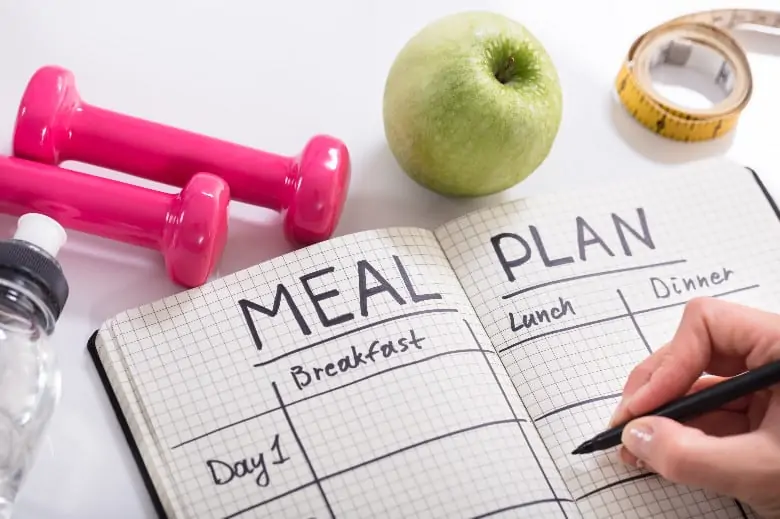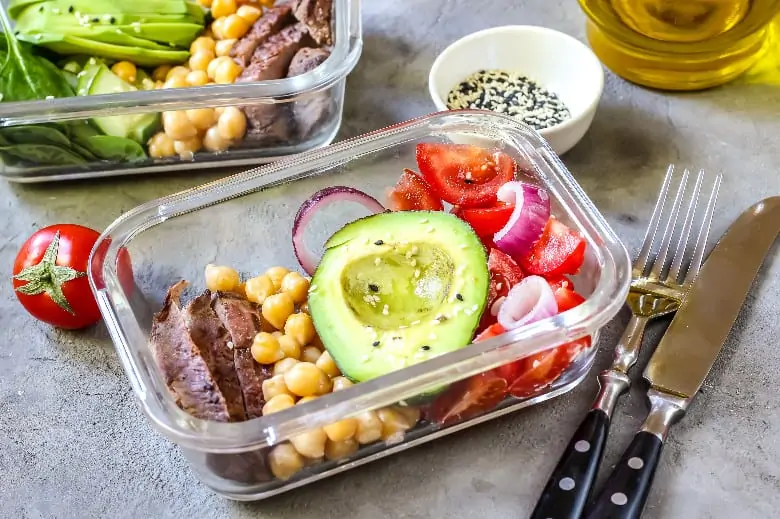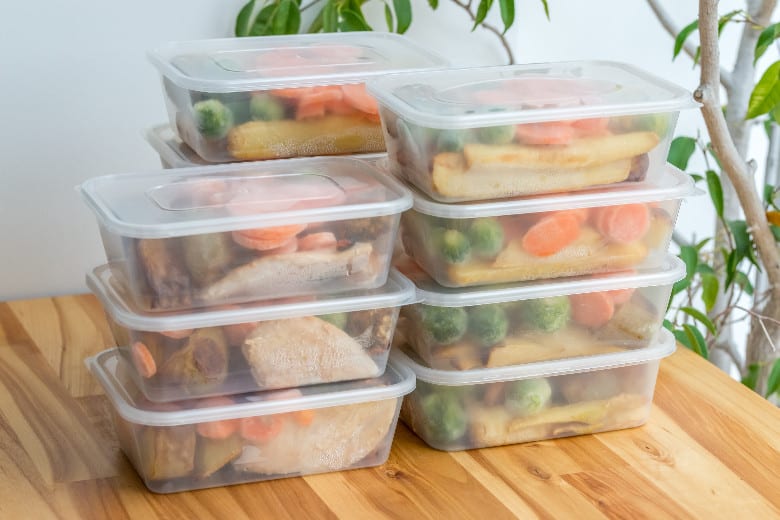Looking for a way to make your week flow more efficiently? Start meal planning. Hectic work weeks and busy family schedules make it hard to get in a quick bite while maintaining a healthy diet.
I can’t tell you how many friends and colleagues I’ve heard complain about not having time to make lunch. Either that or they were too tired to make dinner. My response is always, are you meal planning?
Meal planning reduces the stress of hastily figuring out what to make for work or school lunches. It also means you have a delicious meal waiting at home for dinner. Sounds good, right?
If you’re ready to start planning, I’ve got you covered. I’ll introduce you to the basic steps of meal planning along with some helpful tips I’ve picked up over the years.
Related: Check out our other guides for more useful tips.
Why Bother With Meal Planning?
There are numerous reasons why you should start planning meals. Here are the top five benefits of meal planning, just in case you needed a motivation boost.

Improve Health
I’m not pointing any fingers, but I know a certain individual that makes poor dietary decisions when they get hangry. A healthy meal plan can easily solve this.
By planning, you are more likely to stay fed and happy. You’re also more likely to have healthier snack foods on hand. This means you’ll be less inclined to make rash food choices like gas station pizza breadsticks.
One study even found planned meals correlated to healthier diets and less weight gain. This brings up another point, portion control. Meal planning gives you more control over your serving sizes. Less gluttony equals less unwanted weight gain.
Save Money
All those gas station snacks add up. So do the take-out bills. Eating at home saves money. You can make a meal at home for a fraction of the cost of what you pay for in a restaurant. And, you’ll have more servings per buck.
According to Forbes, dining out will cost you about five times more than cooking at home. Five times! That’s not to say you shouldn’t splurge at all. Skipping one day of cooking is how many of us keep our sanity. This is certainly the case if you have a large family.
The point is to pick and choose. After all, every now and then it’s good to spoil yourself.
Reduce Food Waste
I’m a big proponent of eliminating food waste any way I can. Meal planning is one of those ways.
When you plan a meal, all your fresh ingredients have a purpose. Even your leftovers do. You know what you’re going to eat and when you’re going to eat it. This means you’re much less likely to wind up with spoiled food in your fridge.
If you do happen to have some fresh veggies left after you’ve done all your meal prep, fret not. There are still some recipes you can make and freeze for another week. Now that’s planning ahead!
One dish I swear by for this purpose is frittatas. This is an everything-but-the-kitchen-sink meal that’s good for breakfast, lunch, or dinner. Better yet, it tastes good while reducing food waste.
Reduce Stress
Did you know that meal planning can improve your mood? One study found that taking the choice out of what to eat can decrease stress levels.
While meal planning won’t reduce all your stress, every little bit counts. With dinner decided, you’ll have more time to spend worrying about something else. Like how to wash crayon art off your white walls.
Increase Weeknight Downtime
Busy work weeks don’t leave us with much downtime. This is what makes meal planning so great! Meal planning cuts out all the hard work. That way, when you get home all you need to do is heat and eat.
This means more time to spend with your kids, significant other, or furry friends. Perhaps you can even squeeze in a little more time for yourself. Whatever you choose to do, dinner is already done. You got the rest of the night free.
Meal Planning Steps
Planning your weekly meals in advance can sound daunting and burdensome, but it doesn’t have to be. By following a few basic steps you can knock out all the work and become a pro. There’s even software available if that’s your thing.
Keep in mind, these aren’t hardcore rules set in stone. The key is to be flexible and find what works for you.
Plan A Food Budget
First things first. Before you can even start jotting down your menu for the week, you need to budget.
Everyone’s budget will be different. You might be looking to spend $25, $50, or $100.
The point is to gauge how much you have to spend. That way you have enough for each meal and won’t go spending it all on Alaskan king crab.
Know Your Schedule
Next, take a look at your weekly planner. Do you have any foreseeable 10-hour workdays? What about dinner plans with friends? Perhaps your kids all have soccer practice at different fields on the same day?
Think about how many meals you need to make for the week. I like to prep for at least three days’ worth. If I’m feeling well-organized I’ll shoot for five.
How many days you choose is purely a matter of lifestyle. If you’re a busy mom of five it may help your sanity if dinner for the entire school week is planned, prepped, and ready to feed hungry mouths.
Speaking of which, are you just planning on prepping dinner? Will your crazy week run smoother if you’ve got breakfast, lunch, and snacks figured out too? The trick is to find what works best for your household.
Designate A Day
I am all about meal prep Sunday! However, not everyone may be a fan of spending the last day of their weekend prepping for the workweek.
Set aside a specific time to grocery shop and do food prep. This can be done on the same or different days.
I prefer to do food prep on different days. I find I’m more refreshed and productive when I prepare food on a day when I don’t go shopping.
Take Inventory
Now it’s time to take inventory. Examine the contents of your pantry, fridge, and freezer. Write down what ingredients you have and take note of what needs to get used up.
This may sound like a hassle, but the process goes much quicker than you’d think. It’s also important because it gives you a starting point to plan out your meals.
While you’re at it, I also recommend you take inventory of your food container situation. After all, you’re going to need to put your prepped food into something. If you lent out all your food jars or someone keeps hoarding them at work, you’ll need to add those to your shopping list.
Plan Your Recipes
Figuring out what to make is my favorite part of mealing planning, but it can also be incredibly mind-boggling.
Start with your list of what you already have in your kitchen. If you find you have a ton of one ingredient like black beans, build your favorite recipes around that.
If you’re lacking inspiration, all you need to do is go online. A quick Google or Pinterest search can send you endlessly scrolling, and drooling, for hours. But stay focused!
Find recipes you know you or your family will eat, but don’t stick too strictly to the exact ingredients. Some of the best meals and meal planning practices are born by tweaking a recipe according to what you have in stock.
Once you do find recipes you like, assign them a day. It’s a good idea to choose recipes that suit your schedule. For instance, one-pot meals are fast, easy, and require less cleanup. Of course, nothing beats a quick heat and eat meal on late work nights.
Make A Grocery List
Now that your stomach is growling from sifting through recipes, it’s time to make a list. I know, another list. I promise this is the last one.
Cross-referencing your inventory list and recipes, write down anything you need. Be sure to include the quantity as well. Otherwise, you’ll be standing in the produce aisle wondering if your garlic hummus called for one lemon or two.
Go Shopping
There’s nothing left to do now but go grocery shopping. Grab a cart and get to it. Just don’t forget your list!

Ready, Set, Food Prep
Now that all your meal planning is done, there’s one last thing to do. Prep! This is the most tasking part about meal prep, but the most rewarding.
How you want to tackle this step is up to you. I tend to start with the most labor and time-intensive recipes first. This way I can get them out of the way and save the easy stuff for last.
To avoid a madhouse, I recommend organizing stations on your kitchen counter like a pro. Chopped veggies for one recipe here, meat marinating for another recipe there.
Multitasking will help get the job done faster. Just don’t multitask too much to the point you can’t remember what ingredients go in what dish.
Tips For The Ultimate Meal Plan
Over the years I’ve planned more weeks of healthy meals than I can count. Here are the tricks of the trade I’ve found to be useful week after week.
Buy Versatile Ingredients
What makes ingredients versatile? Ingredients are versatile when they can be used for numerous dishes across the board.
For instance, quinoa and spinach are great because you can toss them in a salad for lunch or a burrito for dinner. Potatoes are another fantastic ingredient. Hash browns for breakfast, bowls for lunch, or patties for dinner, you can incorporate potatoes into an array of quick meals any time of day.
What you don’t want to do is find a lavish recipe that calls for a plethora of ingredients you don’t use on a weekly basis. I’m talking to you miso paste.
Swap Out Proteins
Chicken for dinner again? While chicken is excellent for versatility, you probably won’t want to eat it for every meal. Choose a few different proteins for the week. Say, tofu one night, ground turkey another.

However, don’t go overboard. Your protein choice will typically be the most expensive item on your grocery list. Make it stretch when you can.
Meals like stir-frys or pasta are a couple of good options. That way you can plan meals more easily while not growing tiresome of the same old thing.
Choose Easy Recipes
If you’re making a week’s worth of three daily meals, plus snacks, choose easy recipes.
The last thing you need to do is try to make a laborious recipe like homemade pork and chile tamales. You got enough on your plate (sorry!).
To help you out, here are a few ideas for some quick and easy recipes:
- Sheet pan fajitas
- One-pot pasta
- Slow cooker chili
- Stir-fry
- Breakfast burritos
- Veggie packed grain bowls
- Overnight oats
All these meals can be prepped ahead of time and whipped up with minimal effort. You can also swap out ingredients according to what you’re in the mood for.
Another tidbit I’ve found to be useful time and time again is to cook what you know. It makes prep much more efficient. It also eliminates the need to find new healthy recipes when you don’t have the energy for it.
Cook What You’ll Actually Eat
I know this may sound like a no-brainer, but it has to be said. If you don’t typically eat, say okra, the middle of the week is not the best time to start experimenting. Especially if you have any little ones that are going through a super picky eater phase.
Plan your meals according to what you and your household like to eat. Otherwise, you may find yourself ordering out more than dining in.
Be Flexible
You planned pasta primavera for Wednesday but are really in the mood for sheet pan steak fajitas. That’s ok! The trick to meal planning is being flexible.
Something may come up in a day and you need to change dinner plans. Or, you planned to eat one thing and an ingredient went bad faster than you thought. By adding in some flexibility you’ll stay happy and fed.
Don’t Over Plan
You may have lofty ambitions and plan out an entire week’s worth of meals. While that’s not a bad thing, it can be a bit much. Especially if you try to keep it up every week.
I recommend sticking to three to five days worth of planning and prepping. That’s enough to get you through most of the week while limiting your prep time. That way meal prep Sunday doesn’t become your least favorite day.
Plan For Leftovers
Big batch cooking is one of the best ways to stay on top of your mealing planning. The reason being, leftovers.
Choosing meals that account for leftovers means you get multiple meals in one. Dinner tonight, lunch tomorrow. If you don’t want it for lunch, you can always freeze what’s left and plan to eat it later in the week.

Frozen leftovers are especially a great idea if you have a family. Even though you may have your whole week planned, those unexpected events can and will happen. That’s why it’s good to always have something left over for a quick heat and eat dinner.
Check For Deals
One of the best ways to cut down on your weekly spending is shopping for deals. Buying what’s in season or discounted at your supermarket can greatly stretch your dollar.
Check for sales when making your meal list. Many grocery chains will list weekly deals online. Of course, there are also many apps for that.
However you search, I recommend you do this before going shopping. Otherwise, you may wind up spending more on ingredients that don’t get incorporated into your meal plan.
Spices And Herbs Are Your Friends
Tired of eating the same old thing? Meal planning can easily put you in a rut. But it doesn’t have to.
The simplest, and often cheapest, way to get more out of your ingredients is to be creative with spices and herbs.
For instance, I love making chickpea salads for lunch. They’re quick, easy, and healthy. But they can get tiresome.
That’s when I mix things up a bit. One week I may opt for cumin and parsley. Next week, curry and cilantro. Keep in mind, you should only buy fresh herbs if you plan to use them.
Invest In A Variety Of Food Containers
You’ve done all your prep and now all that’s left is to store your meals in containers. But wait, do you have the right ones?
It’s a good idea to have an array of food containers in varying types and shapes. You’ll want ones for the freezer, fridge, and perhaps microwave.

If you want to make life easier, choose containers that fit your desired portion size and write each person’s name on the container. This will save the hassle of divvying up food later.
One of my favorite lunch containers is a stackable bento box. I can portion out snacks and sides while still having enough space for the main course.
Clean Eating
One of the biggest questions I get asked is how to incorporate clean, healthy eating into meal planning. The key is to balance your plate. You’ll want recipes that call for lean proteins, complex carbs, fresh fruits, and plenty of veggies. The more colorful the plate, the better.
Keep in mind this may not be possible for every single meal. Which is totally to be expected. You’ll want to make sure you incorporate enough variety in a day. For instance, you may opt for blueberry chia seed pudding for breakfast, a garden salad for lunch, and baked chicken and rice for dinner.
Whatever is on the menu, balance your healthy fats and keep portion sizes under control. Avoid choosing ingredients that are filled with empty carbs and sugar. They may give you a quick energy boost, but you’re likely to crash.
Also, don’t forget to drink ample amounts of water! I’m sure you’ve been told time and time again about the importance of staying hydrated. In case you needed one more reason, thirst can be mistaken for hunger. So drink up!
Conclusion
There are so many reasons why it’s worth it to start meal planning. Reduced stress and more downtime to name a couple. Put simply, meal planning just makes life easier.
To the unfamiliar, meal planning may sound like a weekly ritual designed for the coupon clipping thrifty mother of five. But meal planning is for everyone, even you.
By following a few basic steps you can have your meals planned, prepped, and ready to go before Monday morning even rolls around. And just think, the more you meal prep, the better at it you will become.
